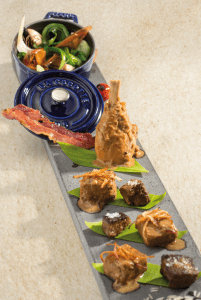Food in Madagascar is a gently spiced fusion of different culinary traditions creating a national cuisine unlike no other. The Malagasy cuisine reflects the country’s cultural diversity by blending the influences from the Arabic, Chinese, French, African and Indian cultures present in Madagascar.
Traditional Madagascar dishes usually contain one main dish of meat, poultry, or fish with a side dish of vegetables, and rice. Malagasy cuisine is known for being quite flavourful despite being prepared in a simple manner without much spice. Typical basic ingredients include onions, tomatoes, garlic, and ginger.
Prepare your taste buds for a tantalising journey through Madagascar’s culinary wonders! From aromatic spices to vibrant flavours, Malagasy cuisine is a symphony of tastes that will leave you craving more. Get ready to embark on a culinary adventure as we unveil the Top 5 Madagascar dishes awaiting you along the breath-taking shores of this wonderful island.
Romazava – Madagascar’s national dish

Romazava is Madagascar’s over-the-top national dish. This hearty stew is made with zebu (beef), and sometimes pork, that’s been sautéed with ginger, garlic, tomato, and onion. The rich broth is then simmered until the meat is tender and bursting with flavour.
It’s usually served with a steaming portion of vary (rice) and a dollop of sakay, a fiery red pepper sauce, for those who like a bit of heat. The rich and flavourful broth, combined with the tender meat, makes Romazava a truly satisfying dish.
Whether savoured in the heart of the bustling markets or served with elegance in a coastal resort, Romazava remains a timeless symbol of Malagasy hospitality and flavour.
Check out our recipe for Royal Romazava, served at Constance Tsarabanjina.
Lasopy – a Malagasy vegetable soup
Lasopy is a rich vegetable soup flavoured with veal bones. The bones are taken out before serving and the soup together with the vegetables is pureed and served in thick earthenware bowls. Lasopy is generally served as a starter and is definitely one of Madagascar’s star dishes you shouldn’t miss. The stock of the Lasopy soup is also often used to boil the rice that is the base of nearly all the Malagasy cuisine.
Varenga – a traditional Malagasy meat dish
Varenga is a delicious, traditional Madagascar meat dish. It is made with a combination of beef, salt, garlic, and sliced white onion. The dish is slowly simmered until the meat becomes tender and starts to fall apart. The beef is then shredded and roasted until crispy and browned. Varenga is usually served with white rice and hot sauce on the side.
Vary Amin ‘anana – Malagasy style breakfast
Vary Amin Anana (“rice with greens”) is a savoury rice porridge, where the rice and various vegetables are cooked together. It is usually made with a combination of onions, ginger, tomatoes, oil, water, rice and leafy greens such as kale. It may also sometimes include meat or fish. The ingredients simmer until tender and the water is almost entirely absorbed. Vary Amin Anana is traditionally consumed as part of the Malagasy breakfast. Again, the Madagascans like to eat this with sakay pepper sauce.
Salady Voankazo – Madagascar’s famous fruit salad
Salady Voankazo is a delicious, refreshing fruit salad and one of the most popular desserts in Madagascar. It takes advantage of any fruit which happens to be in season including bananas, mangos, pineapples as well as strawberries and lychees. The fruit is cut up and gracefully flavoured with a sweet syrup and vanilla, an ingredient that the country is famous for.
So, are you ready to tantalize your taste buds with the unique flavours of Madagascar? From savoury stews to refreshing fruit salads, Malagasy cuisine has something to offer for every palate. So, pack your bags, book your flight, and embark on a culinary adventure to the beautiful island of Madagascar!
Read more
- Find out more about our restaurant at Constance Tsarabanjina, Madagascar!
- Try our recipe for Langouste with Madagascan vanilla
- Get to know the stunning landscapes of Madagascar!





No Comments